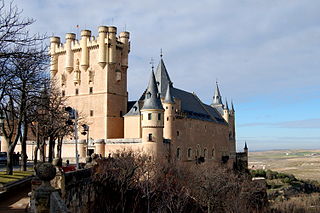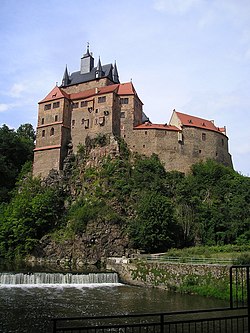
Blankenstein Castle is a castle located on the south side of the river Ruhr in Hattingen, North Rhine-Westphalia, Germany.

The 140-kilometre-long road, the Silver Road is the first and longest holiday route in the German Free State of Saxony. Against the background of the importance of mining in the history of Saxony, the road links those sights and tourist attractions of the Ore Mountains and its foreland that relate to the centuries-old mining and smelting industries of the region.
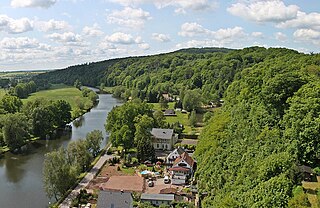
Rochlitzer Berg is a mountain of volcanic origin in Saxony, southeastern Germany. It is situated south-west of the town of Rochlitz on the river Zwickauer Mulde. Its elevation is variously given as 348.9 m NHN, 348 m HN or 353 m NN. The mountain is also known as Rochlitzer Collm.

The Ore Mountain passes are crossings and passages over the crest of the Ore Mountains in Central Europe, over which tracks, roads, railway lines and pipelines run from the Free State of Saxony in the Federal Republic of Germany to Bohemia in the Czech Republic and vice versa.

Eisenhammer Dorfchemnitz is an historic hammer mill in Dorfchemnitz in the Ore Mountains of Germany. The mill is an important witness to proto-industrial development in the Ore Mountains. Of the once-numerous hammer mills only three others remain working in Saxony apart from the Frohnauer Hammer: the Frohnauer Hammer Mill, the Grünthal Copper Hammer Mill and the Freibergsdorf Hammer Mill.

Hohnstein Castle is a medieval castle in the village of the same name, Hohnstein in Saxon Switzerland in the Free State of Sachsen in East Germany.
The Schwarzbach railway was a 750 mm Saxon narrow-gauge railway in Saxon Switzerland. It began in Goßdorf-Kohlmühle station on the Sebnitz Valley railway and ran along the valley of the Schwarzbach to Hohnstein.

Dohna Castle on the once important medieval trade route from Saxony to Bohemia was the ancestral castle seat of the Burgraves of Dohna. Of the old, once imposing double castle only a few remnants of the walls remain. The ruins of the old castle are located on the hill of Schlossberg near the subsequent suburb of the town of the same name, Dohna, in the district of Sächsische Schweiz-Osterzgebirge in Saxony, Germany.

Scharfenstein Castle lies on an elongated hill spur above the village of Scharfenstein, in the municipality of Drebach in the Ore Mountains of Saxony, Germany. The castle is one of 24 sites run by the state-owned State Palaces, Castles and Gardens of Saxony.
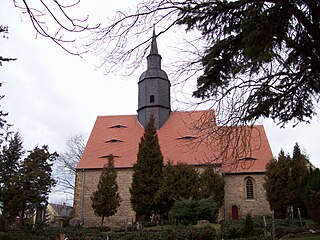
The Holy Way came about as a result of the canonization of Bishop Benno of Meissen. It led from Bohemia to Meissen and ran between Grillenburg and Wilsdruff in the present-day district of Sächsische Schweiz-Osterzgebirge in the opposite direction and parallel with the Saxon St. James' Way. Original sections of the route have survived, for example in the Tharandt Forest between Grillenburg and Spechtshausen.

A Saxon milepost was a milepost in the former Electorate of Saxony that gave distances expressed as journey times to the nearest eighth of an hour. With one hour being the equivalent of one league, this corresponds to a distance of about 566 m. The design of the mileposts varied according to the distance at which they were placed. They were hewn from natural stone into the shape of an obelisk, an ancient herma or a stele. Their prototype was the Roman milepost. From its German name römische Meilensäule the rather inaccurate German description of Säule was derived. The Saxon head postal director (Oberpostdirektor), Paul Vermehren, brought about their inception based on official distance surveys, whose results were given in leagues on the post mileposts. A league in Saxony at that time was meant to be an hour's journey, equivalent to half a mile or 4.531 kilometres.

The classification of natural regions of Saxony shown here was produced between 1994 and 2001 by a working group called "Ecosystem and Regional Character" at the Saxonian Academy of Sciences in Leipzig as part of the research and development project "Natural Regions and Natural Region Potential of the Free State of Saxony" at a scale of 1:50,000 as the basis for the rural development and regional planning. This was also supported by the Saxon State Ministry of the Environment and Agriculture and the Saxon Ministry of the Interior.

The Saxon-Lower Lusatian Heathland is a natural region in the German state of Saxony. The current natural region division of the Free State of Saxony groups landscape units of the upper geochore or sub-regional level into three "Saxon natural regions" to produce a large-scale classification. These are part of higher order (cross-border) natural regions, whereas the landscape units previously used described areas that were largely confined within the borders of Saxony.
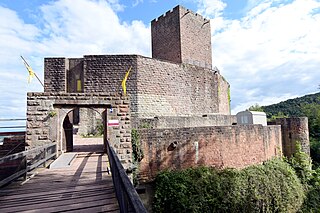
Landeck Castle is a ruined hill castle southwest of Landau, near Klingenmünster in the county of Südliche Weinstraße in the German state of Rhineland-Palatinate.

Rochsburg Castle, which was probably founded in the late 12th century, stands on a rock spur, surrounded on three sides by the Zwickau Mulde river, above the eponymous town quarter in Lunzenau in Saxony. The medieval site and its division into the inner bailey, outer bailey and two zwingers is still easy to recognise. In its present appearance the schloss dates, however, to the Late Gothic and Renaissance periods. Its main construction phases date to 1470 and 1548; it is an important example of Renaissance architecture in Saxony. Over centuries the Rochsburg has formed the centrepiece in the Saxon district of Rochsburg.

Wolf Caspar Klengel, from 1664 von Klengel, was a German architect in Saxony,
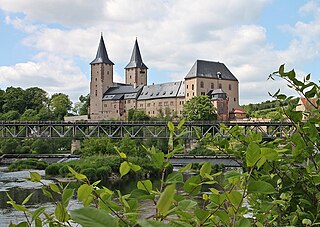
Rochlitz Castle or Rochlitz Palace lies in the west of the town of Rochlitz in the county of Mittelsachsen in the Free State of Saxony. It was built on the site of an imperial castle, erected in the second half of the 10th century, which fell into the possession of the Wettin margraves in 1143. Its appearance, which includes several Romanesque wings, is considerably influenced by its remodelling into a margravial schloss in the fourth quarter of the 14th century. Further conversions and additions followed at the end of the 15th and in the 16th centuries, when the castle became a secondary residenz, dower house and hunting lodge for the Wettin family. The castle or palace was the residence for members of the Saxon princely house eight times. From the 18th century the castle served as an administrative centre ; in 1852 it became a gaol, which necessitated considerable alteration. The museum founded in 1892 was gradually expanded and, today, takes up almost the entire castle.
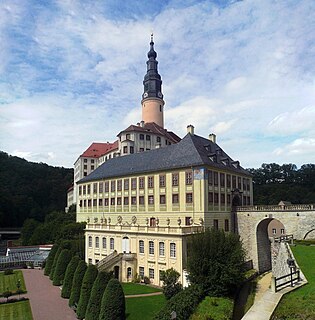
Schloss Weesenstein is a Schloss located in Weesenstein, a small village, part of Müglitztal in the Müglitz river valley, around 3 kilometres (1.9 mi) south of Dohna in Saxony, Germany.

Schauenburg Castle is a ruined hilltop castle located in Oberkirch, Germany, atop a 367-metre-high (1,204 ft) (NN) hill spur overlooking the Rench river valley above the town of Gaisbach, Baden-Württemberg. The castle was built by Duke Berthold II of Zähringen.

Mildenstein Castle, in German Burg Mildenstein, also called Schloss Leisnig, is located in Leisnig in Landkreis Mittelsachsen, Saxony, Germany. It is a property of the Free State of Saxony and is administrated by the company State Palaces, Castles and Gardens of Saxony.



